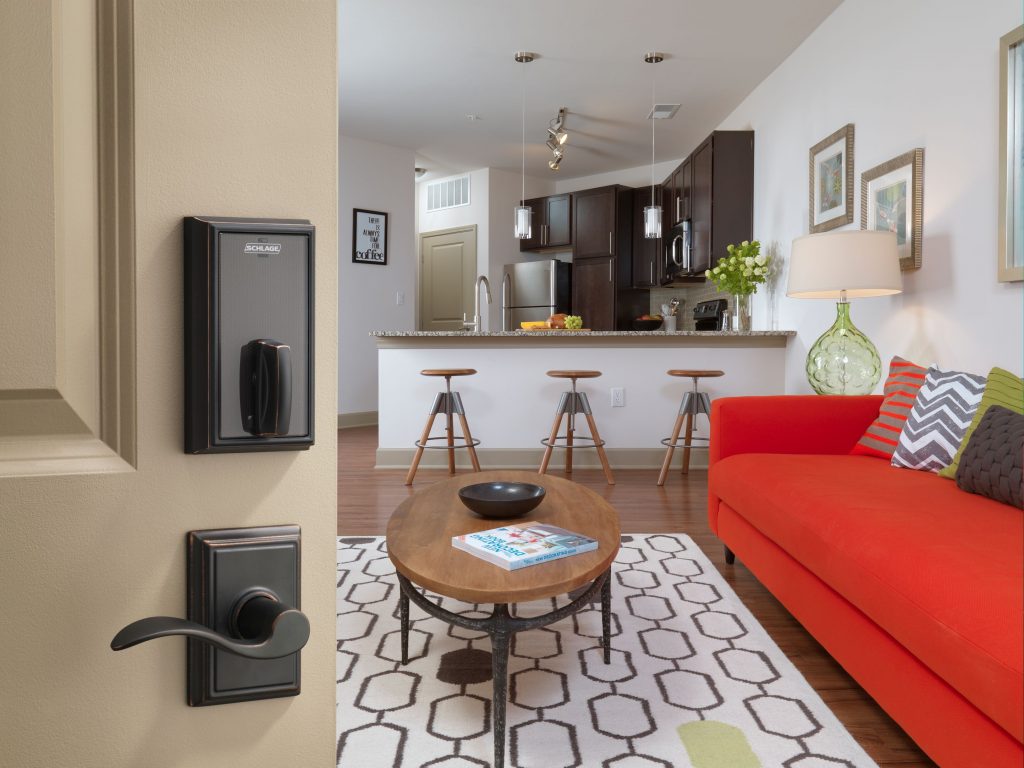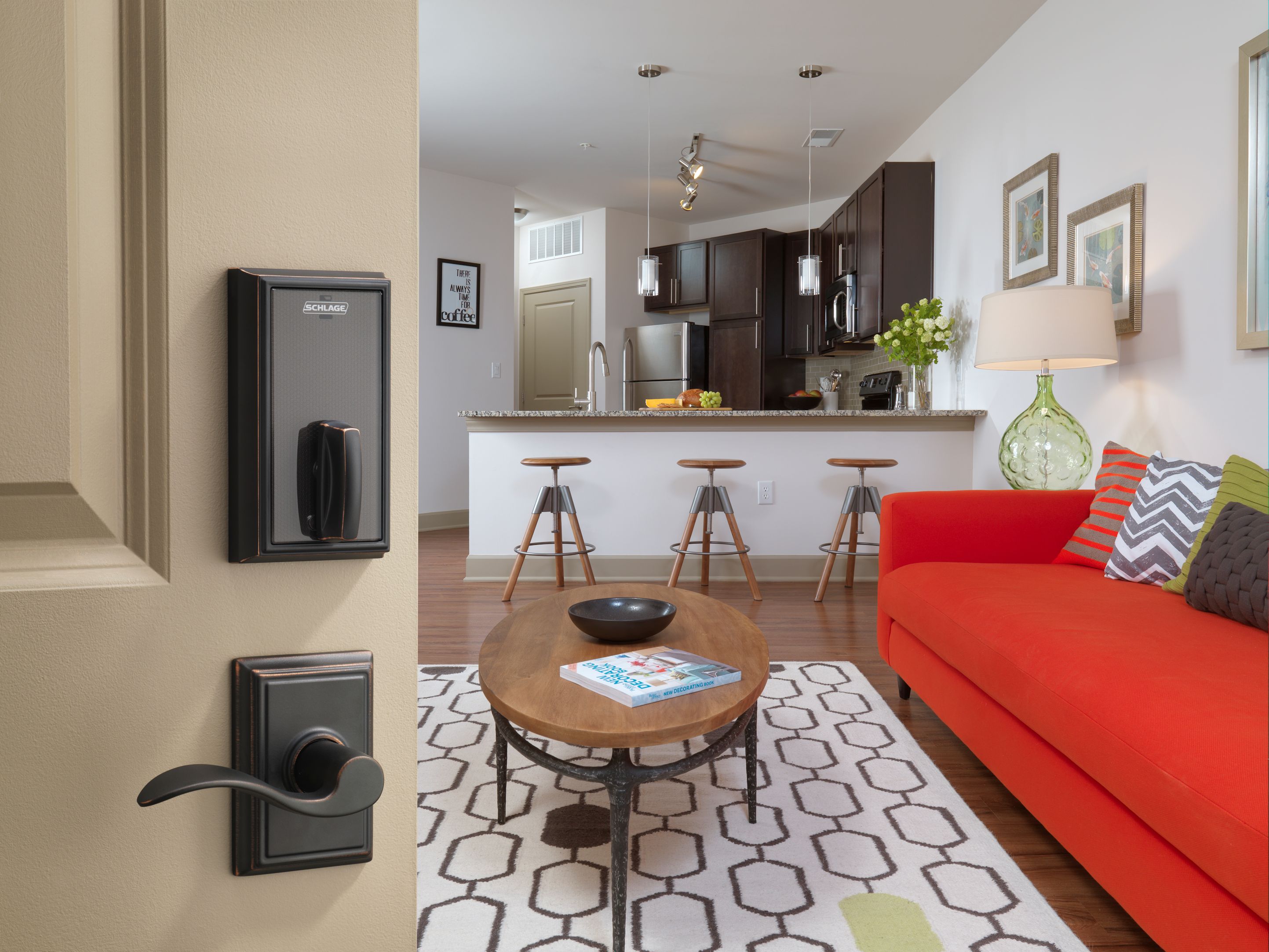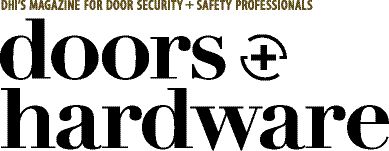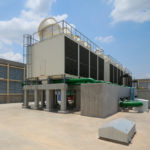This post was published in Doors & Hardware
.
According to the International Building Code (IBC) and NFPA 101 – The Life Safety Code, most doors in a means of egress are required to unlatch with one releasing motion (the act of opening the door is not required to be part of the single motion). This means that when a building occupant approaches an egress door, they can turn a lever, push the touchpad on a panic device, or perform a similar operation, and the latch(es) will be retracted. In most cases, it is not acceptable to have more than one lock or latch requiring multiple operations to release the latches, for example, a latchset with a separate deadbolt.
One exception to this rule is when a door leads to a residential dwelling unit or sleeping unit. The IBC exception states: “Doors from individual dwelling or sleeping units of Group R occupancies having an occupant load of 10 or less are permitted to be equipped with a night latch, dead bolt or security chain, provided such devices are openable from the inside without the use of a key or tool.”
 For Group R dwelling units and sleeping units, with an occupant load of 10 or less, a latchset (typically required to maintain the fire rating) and a separate deadbolt or other security device is allowed in most jurisdictions. The locking/latching devices must be operable without the use of a key or tool, so a double-cylinder deadbolt would not meet this requirement.
For Group R dwelling units and sleeping units, with an occupant load of 10 or less, a latchset (typically required to maintain the fire rating) and a separate deadbolt or other security device is allowed in most jurisdictions. The locking/latching devices must be operable without the use of a key or tool, so a double-cylinder deadbolt would not meet this requirement.
This exception would apply to most apartments, condominiums, dormitory rooms, hotel rooms, and other units as defined by the IBC. It’s important to note that assisted living facilities, group homes, residential board and care facilities, and similar facilities are considered Institutional occupancies by the IBC, not Residential occupancies. Because these are Group I occupancies and not Group R occupancies, the IBC exception does not apply.
NFPA 101 includes similar language to the IBC, stating: “Egress door assemblies from individual living units and guest rooms of residential occupancies shall be permitted to be provided with devices, including automatic latching devices, that require not more than one additional releasing operation, provided that such device is operable from the inside without the use of a key or tool and is mounted at a height not exceeding 48 in. (1220 mm) above the finished floor.” NFPA 101’s occupancy classifications are slightly different from the IBC, but NFPA 101 defines a Residential occupancy as one that provides sleeping accommodations, except for occupancies associated with health care or detention and correctional use. This would include 1- and 2-family dwellings, lodging or rooming houses, hotels, motels, and dormitories, and apartment buildings.
The accessibility standards that are most commonly used in the United States – ICC/ANSI A117.1 and the ADA Standards for Accessible Design, require hardware to be operable with no tight grasping, tight pinching, or twisting of the wrist, but do not require the latch(es) to be released with one operation. Some states and local jurisdictions may have adopted requirements which DO require one releasing operation for egress – even on dwelling units – so check the local codes for more information. If a separate deadbolt or security device is not allowed, an interconnected lock or a mortise lock incorporating a deadbolt may be used, as long as turning the inside lever retracts both the latchbolt and the deadbolt.
Because most dwelling-unit and sleeping-unit doors that open onto an interior corridor are fire door assemblies, the doors are typically required to be self-closing, with positive-latching hardware. For dormitory applications, automatic-closing devices that are actuated by smoke detection can be a good application. These openings may also require smoke gasketing to limit air infiltration to the maximum set by the code when tested in accordance with UL 1784. Thresholds are not usually required in order to maintain the fire rating, but are often used to limit sound transmission through the opening. All hardware installed on a fire door assembly, including hinges, locks, closers, protection plates, gasketing, thresholds, and viewers must be listed/labeled for that purpose. When retrofitting existing fire door assemblies for new hardware, job-site preparations and field modifications must comply with NFPA 80 – Standard for Fire Doors and Other Opening Protectives.
Most dwelling units must also comply with the Fair Housing Act, which typically requires dwelling unit entrance doors to meet the accessibility standards. This would affect the clear opening width, threshold height, maneuvering clearance, opening force (non-fire-rated doors), closing speed, and operable hardware. Refer to the previous Decoded article on the Fair Housing Act for more information.
You need to login or register to bookmark/favorite this content.







Lori,
I remember when this came up not too long ago and you helped me research this information. This exception is a strange one. It seems to be opposite of everything we know about fire doors. But, here it is.
Lori….Working on third apartment/student housing building. This one has 203 apartments, 12 are two bedroom handicap units. We are using the FE410f for the front doors along with proper closing options and seals. The issue that comes up deals with the 12 set of double bedrooms and providing privacy and security for the room. Arch wants privacy only. The building owner wants another fe410f on the door. Can the fe410f be set to a non-auto lock function. They are afraid to use fe467 and passage set or privacy set. They think it would no meet code in RI. What are your thoughts????
One Simple Answer, would be to Use Mortise Entry Locks with a Dead-Bolt Built in, this gives the Security of the Dead-Bolt, but allows for the ability for Free Egress with One Action, when using a Lever Set on the Secured Side of the Door.